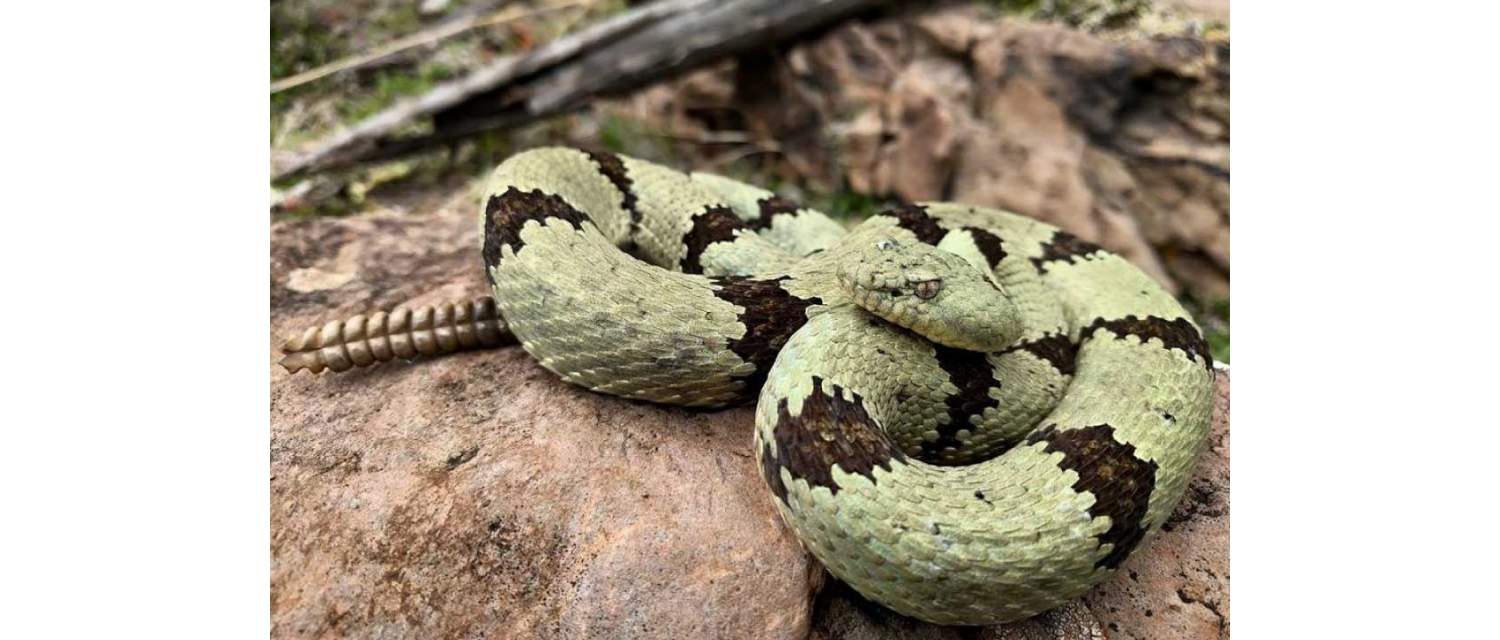
Crotalus lepidus
(Kennicott, 1861)
Nombre común:
Reino:
Phylum:
Clase:
Orden:
Suborden:
Familia:
Género:
Especie:
Subespecies:
Descripción:
Tiene una cabeza triangular distinguible del resto del cuerpo; detrás de los ojos presenta una línea negra que se extiende hasta el ángulo del hocico. Presenta variaciones de color durante sus distintas fases de crecimiento así como entre poblaciones. Como un patrón general presenta un color de fondo grisáceo o verdoso (que puede variar entre claro u oscuro) algunas veces amarillento. En el dorso tiene una serie de manchas transversales que inician en la nuca y van de 14 a 24 y son café oscuro o negras las cuales están bordeadas por una serie de escamas claras o blanquecinas. El color del vientre también es variable; generalmente es gris con manchas rosas que se torna casi negro hacia la cola. Algunas veces esta es de color amarillo brillante sobre todo cuando son jóvenes. El cascabel es grande en relación con su tamaño.
Tamaño:
Hábitos:
Alimentación:
Reproducción:
Número de crías:
Distribución geográfica:
Distribución en México:
- Aguascalientes
- Chihuahua
- Coahuila
- Durango
- Jalisco
- Nayarit
- Nuevo León
- San Luis Potosí
- Sinaloa
- Sonora
- Zacatecas
Hábitat:
Estatus de protección:
IUCN:
Literatura citada:
Bryson, R. W. 2007. Fotopirsch auf Gebirgsklapperschlangen. Reptilia (Münster) 12 (4): 32-37. Bryson, R.W. & Lazcano, D. 2005. Gerrhonotus parvus. Reptilia (GB) (39): 69-72.
Campbell, J.A. & Lamar, W.W. 1989. The Venomous Reptiles of Latin America. Comstock Publishing/Cornell University Press, Ithaca. Campbell, J. & W. Lamar. 2004. The Venomous Reptiles of the Western Hemisphere. Cornell University Press. 898 pp. Conant, R. 1955. Notes on three Texas reptiles, including an addition to the fauna of the state American Museum Novitates (1726): 1-6.
Conant, R. & Collins, J. T. 1991. A Field Guide to Reptiles and Amphibians of Eastern/Central North America, 3rd ed. Houghton Mifflin (Boston/New York), xx + 450 p.
Gloyd, H. K. 1936. The subspecies of Crotalus lepidus Occasional Papers of the Museum of Zoology, University of Michigan (337): 1-5 + 1 plate.
Gloyd, H. K.; Smith, H. M. 1942. Amphibians and reptiles from the Carmen Mountains, Coahuila Bulletin of the Chicago Academy of Sciences 6 (13): 231-235.
Greene, H. W. & Campbell, J. 1992. The Future of the Pitvipers. En: Biology of the Pitvipers Texas, USA. Greene, H. W. 1997. Snakes. The Evolution of Mistery in Nature. University of California Press. 351 pp.
Hammerson, G.A., Frost, D.R. & Santos-Barrera, G. 2007. Crotalus lepidus. In: IUCN 2008. 2008 IUCN Red List of Threatened Species.
Downloaded on 21 December 2008. Kennicott , R. 1861. On three new forms of rattlesnakes. Proc. Acad. Nat. Sci. Philadelphia 13: 206-207. Klauber, L. M. 1972. Rattlesnakes: Their habits, life histories and influence on mankind. Berkeley: University of California Press. Lazcano, D.; J. Galván, R. D.; de la Peña, C. G. & Castañeda, G. 2007. Terrarienhaltung von Gebirgsklapperschlangen. Reptilia (Münster) 12 (4): 38-41. Lowe, Ch. H., Schwalbe, C. R. & Johnson, T. B. 1986. The Venomous Reptiles of Arizona. Arizona Game and Fish Dept. Phoenix, Arizona, USA. McDiarmid, R. W.; Campbell, J. A. & Touré, T. A. 1999. Snake species of the world. Vol. 1. Herpetologists’ League, 511 pp. Ramírez Bautista, A. y M. C. Arizmendi. 2004. Crotalus lepidus. Sistemática e historia natural de algunos anfibios y reptiles de México. Facultad de Estudios Superiores Iztacala, Unidad de Biología, Tecnología y Prototipos (UBIPRO), Universidad Nacional Autónoma de México. Bases de datos SNIB-CONABIO. Proyecto W013. México. D.F. Stebbins, R. C. 1985. A Field Guide to Western Reptiles and Amphibians, 2nd ed. Houghton Mifflin, Boston. Tanner, W. W., J. R. Dixon and H. S. Harris 1972. A new subspecies of Crotalus lepidus from western Mexico. Great Basin Naturalist 32 (1):16-24. Winchell, S. 2007. Klapperschlangen! Die Gattung Crotalus. Reptilia (Münster) 12 (4): 18-25.

